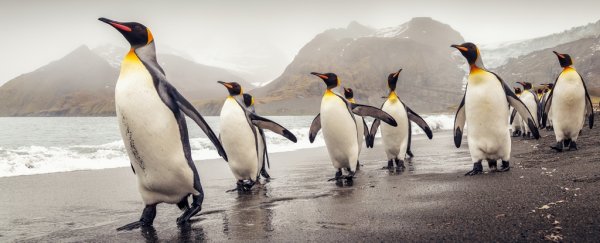Penguins are no strangers to climate change. Their life history has been shaped by rising and falling temperatures, and their bodies are highly specialized for some of Earth's most extreme conditions.
And yet, scientists are concerned the evolutionary path of the penguin may be grinding to a halt, thanks to what appears to be the lowest evolutionary rates ever detected in birds.
A team of international researchers has just published one of the most comprehensive studies of penguin evolution to date, which is the first to integrate data from living and fossil penguin species.
The research unveils the tumultuous life history of penguins in general, with three-quarters of all known penguin species – now represented by fossils only – already extinct.
"Over 60 million years, these iconic birds have evolved to become highly specialized marine predators, and are now well adapted to some of the most extreme environments on Earth," the authors write.
"Yet, as their evolutionary history reveals, they now stand as sentinels highlighting the vulnerability of cold-adapted fauna in a rapidly warming world."
On land, penguins can appear a bit ridiculous, with their awkward waddle and seemingly useless wings. But underwater, their bodies are transformed into hydrodynamic torpedoes that would make any fleeing fish wish it could fly.
Penguins had already lost their ability to fly 60 million years ago, before the formation of the polar ice sheets, in favor of wing-propelled diving.
The fossils and genomic data suggest the unique features that enable penguins' aquatic lifestyles emerged early in their existence as a group, with rates of evolutionary change generally trending downwards over time.
The scientists think penguins originated on a Gondwanan micro-continent called Zealandia, which is now mostly submerged under the ocean.
The paper suggests the ancestors of modern penguins – crown penguins – emerged approximately 14 million years ago, a whole 10 million years after genetic analyses have hinted at.
This particular period would coincide with a moment of global cooling named the middle Miocene climate transition. Living penguins, however, split into separate genetic groups within the last 3 million years.
Penguins spread out across Zealandia before dispersing to South America and Antarctica multiple times, with later groups likely hitching a ride on the Antarctic Circumpolar Current.
The scientists found that almost every penguin species experienced a period of physical isolation during the Last Glacial Period.
Their contact with other penguins was limited during this time, as groups were forced to live in more fragmented areas of habitat further north, where they could still find food and shelter.
As a result, the DNA pool of each group became narrower, pushing species further apart genetically.
In the period of warming that followed, they moved back towards the poles, and some groups, now much more genetically distinct, crossed paths once more.
The way certain groups of penguins experienced these significant climate events offers insight into how they might cope with human-caused climate change.
The groups that increased in number when warming occurred shared some features: They were migratory, and foraged offshore. The researchers think these features allowed them to respond to changing climates better, especially the ability to look further afar for prey and to move to lower latitudes.
Those that decreased in number, on the other hand, lived in one particular place, and foraged closer to shore for food: a lifestyle that doesn't cope too well when the conditions 'at home' drastically change.
But penguins' ability to change might be limited by more than just lifestyle – it seems to be embedded in their genes.
It turns out that penguins have the lowest evolutionary rates yet detected in bird species, along with their sister order, Procellariiformes, which includes birds like petrels and albatrosses.
The researchers compared 17 different orders of birds overall, using several genetic signatures closely related to rates of evolutionary change.
They noticed that aquatic birds generally had slower rates of evolution than their terrestrial kin, so they think the adoption of an aquatic lifestyle might go hand-in-hand with low evolutionary rates. They also think that evolutionary rates in birds are lower in cooler climates.
The order Pelecaniformes, which includes seafaring birds like pelicans and cormorants, were a near third for lowest evolutionary rate, and waterfowl (order Anseriformes) had much lower rates than earthbound fowls like turkeys, chickens, and quails (order Galliformes).
The researchers note that the ancestral crown penguins evolved at a faster rate than living penguins, but even then, this was slow compared to other birds.
Half of all living penguin species are endangered or vulnerable, and the scientists say their slow evolutionary rates and niche lifestyles could send penguins towards a dead end.
"The current pace of warming combined with limited refugia in the Southern Ocean will likely far exceed the adaptive capability of penguins," they write.
"The risks of future collapses are ever-present as penguin populations across the Southern Hemisphere are faced with rapid anthropogenic climate change."
This research was published in Nature Communications.
